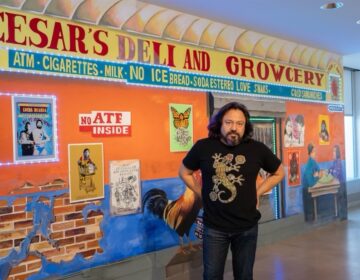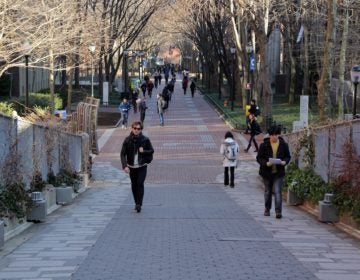Philly high schoolers and college students team up for a ZIP code art project
The students worked together to create a collage based on how their location and background influenced their life.
Listen 2:02
Chrisma Tucker, a 17-year-old student at Revolution School, explains her collage reflecting on the majority white, two-parent households in her neighborhood during a collaborative art project at the University of the Arts on Oct. 10, 2023. (Kimberly Paynter/WHYY)
From Philly and the Pa. suburbs to South Jersey and Delaware, what would you like WHYY News to cover? Let us know!
Chatter in the small classroom at University of the Arts turned into a crescendo of laughter.
Pausing for a quick announcement, University Arts lecturers instructed a group of 30 high school and college schools to think about their ZIP code story.
The term refers to the intersection of class and other identities, and how a person’s story is defined not only by race or citizenship status, but also class dynamics.

One by one, students lined up and picked up their supplies, including glue sticks, scissors, and paper in the back of the room. They made their picks from a stack of magazines and started work on a collaborative collage project inspired by CJ Gross’s book, “What’s Your Zip Code Story?”
“It’s interesting to hear people’s story and not put them in a box with what they may know or not know,” Gross said, as he walked from table to table.

Scissors sliced through construction paper and collages took shape. High schoolers from Revolution School bounced around ideas with University of the Arts college students.
The author paced around the room, stopping to speak with some of the students and asking what it meant to pull certain images. The answers surprised him.
“I’m just inspired. I don’t know. I — I don’t have any words. I’m just in awe of all this happening right here.”

Some collages hearkened to students’ homelands, like the young siblings who were raised in Australia, with rich forest green paper and snippets of blues pieced together in a half circle.
Lo Parks, an interdisciplinary artist at the university, sat at that table with another art student who was from West Philadelphia.
“There’s a pretty consistent overarching theme of the color blue and green and working with nature. Pretty much everyone’s looking for, like, trees and mountains and watercolors and stuff like that,” Parks said.

Others, like Lillie Cirino, cut out images she found of the Klu Klux Klan.
Gross looked perplexed, engaging with Cirino about her upbringing in Alabama. The U of Arts student said her part of the collage was unplanned, but she knew she wanted something patriotic.
Then she found it.

Five years ago, the KKK had come to her family’s doorstep posting signs for those interested to join. Her ZIP code story is unique to her upbringing in the South.
Author CJ Gross was engrossed in conversation with Cirino. He never thought he would hear someone her age speak of that experience.
But that was the point, he said.
Watching the collages unfold was eye-opening for him and some of the art professors.
“What’s so special about today is watching them give their creative practice a new voice,” said Christa DiMarco, an art history professor at U of Arts.

She and Jane Shore, founder of Revolution School, decided to partner on this project bringing together high schoolers and college students to create a work of art in a collaborative environment. The collages will then be displayed at the Free Library of Philadelphia.
Stephen Cirino, Vice President of Diversity Equity and Inclusion at U of Arts, says the project is a connector and is a way of “coming together and seeing how your own story may connect with someone else’s.”
“It may not connect but now you can understand someone’s individual experience.”
This iteration of the ZIP code project took a different form, uniting efforts from people of various age groups, backgrounds, and international regions.

On Oct.11, they hosted 27 students from 21 different ZIP codes, representing half of the ZIP codes in Philadelphia.
“We really see that as a way to not only connect with one another, but also to lean into the kinds of things that we all need. Communication, cultural awareness, understanding of one another, so that we can bridge divides that are existing,” Shore said.
WHYY is your source for fact-based, in-depth journalism and information. As a nonprofit organization, we rely on financial support from readers like you. Please give today.







